Aviation Safety Monitor Weekly Report for the Week Ending June 15, 2024
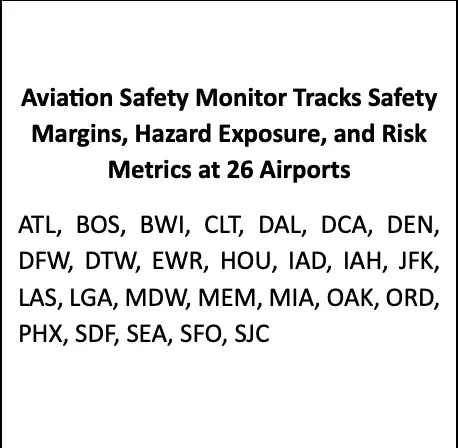
Welcome back to the Weekly Aviation Safety Report. Every Monday Robust Analytics reports on safety margins at 26 United States airports. With this Aviation Safety Monitor Weekly Report, Robust Analytics offers the aviation community timely assessments of changing safety margins and safety-related events. Dates and times are tracked in UTC and the week ends at midnight every Saturday. This week’s report includes data through 2400 UTC on June 15, 2024.
For New Readers: Please read our article “Did Safety Degrade in the National Airspace System in the Winter of 2022-2023?” that applies our methods and data to examine whether safety margins decreased during the events of winter 2022-2023.
The Aviation Safety Monitor measures safety margins by estimating the frequency, duration, and severity of buffer encroachments. Our paper “How Do We Measure Safety Margins?” provides a detailed description of the methods and data. That article can be found here https://www.robust-analytics.com/measure on the Robust Analytics website.
Weekly Safety Margin Update. Safety margins improved slightly over the past week, continuing the high safety margins that we typically observe during the summer months. Total encroachment durations for the week ending June 15 dropped 10.7 percent from the previous week. The number of encroachment events also decreased, falling by 6.7 percent and reversing the small increases of the previous two weeks. Average encroachment durations for the first two weeks of June are 3.5 percent below the May average. The months long trend in low duration per event continued, with as the weekly encroachment duration per event dropped 17.2 seconds, well below the long term average duration per encroachment of 26.3 seconds. Figure 1 displays weekly summary metrics for the 26 monitored airports.
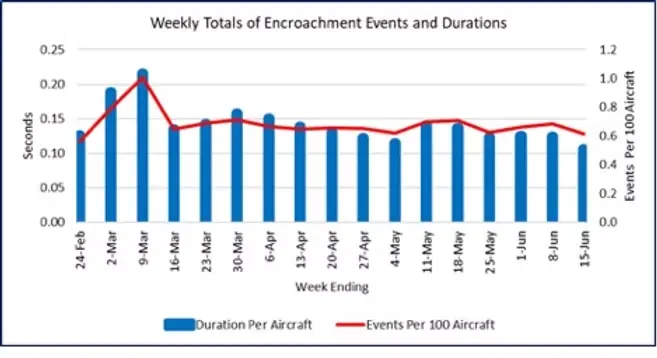
Figure 2 displays the typical time of day pattern that we observe in the data, as encroachment events are highly correlated with traffic density. Even after aggregating the data over 17 metroplexes operating in three time zones the time of day pattern remains prominent. We also observe a frequently-repeated pattern of daily peaks increasing early in the week and then declining. The rest of the week was quiet with all other values within the normal range. The week ending June 15 was quiet, with only two one-hour periods reporting encroachment durations above the 75th percentile.
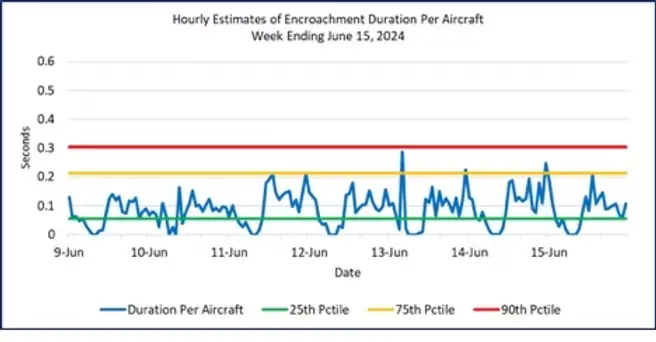
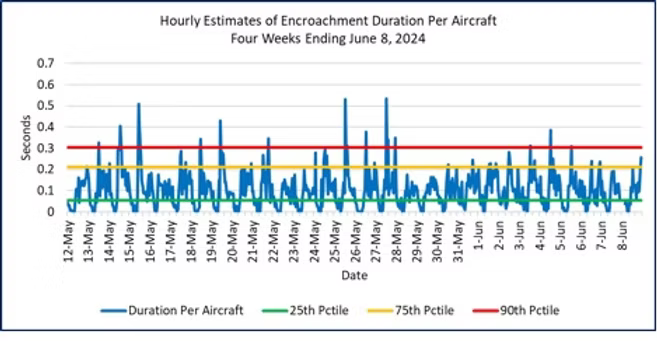
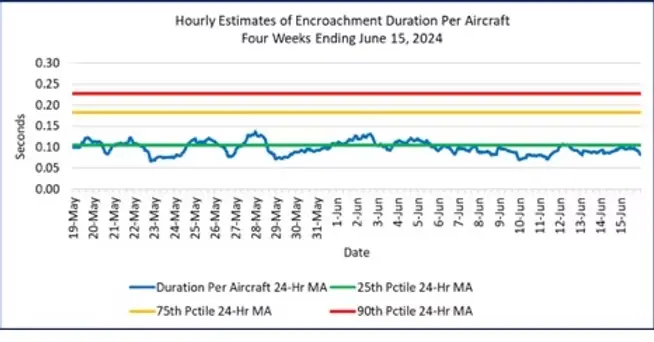
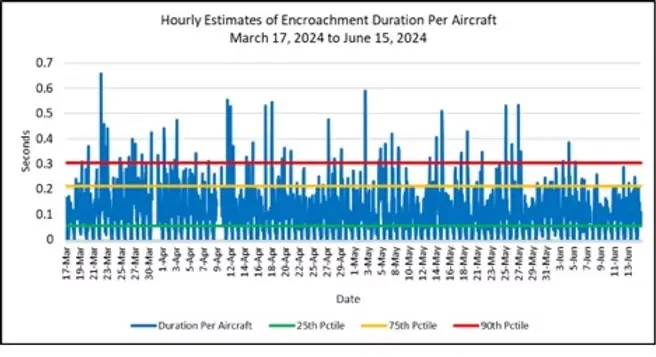
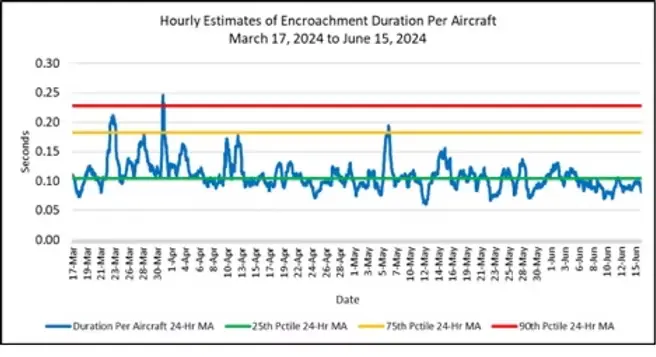
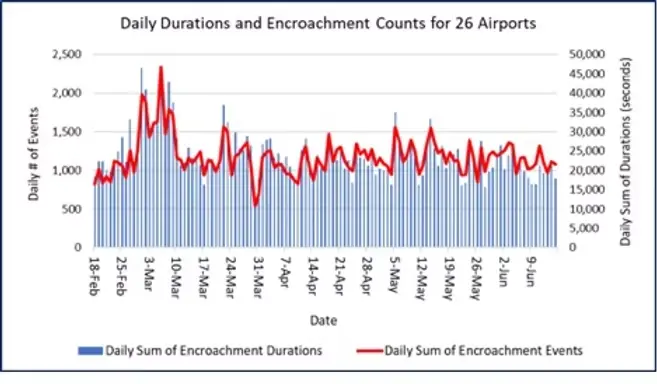
February 18, 2024 through June 15, 2024
How severe are these encroachments? The FAA defines three separation conformance categories based on how far they are from the separation index. (See the description “How Do We Measure Safety Margins?” for details on the conformance categories and how we measure them.) In that classification system, Conformance Categories A and B are the most severe. Under our definition of a buffer encroachment, Category A and B encroachments are counted under all meteorological conditions.
Figure 8 displays information on the most severe separation conformance categories. The daily durations and event counts for the sum of Category A and B encroachments are shown in Figure 7. The pattern differs from the Figure 1, as there is no strong trend during the time period. However, the slight upward drift since the start of May continued over the past week. This suggests that Category PE and C encroachments are affected by different factors from Category A and B. We will take a deep dive into those differences in a future weekly report.
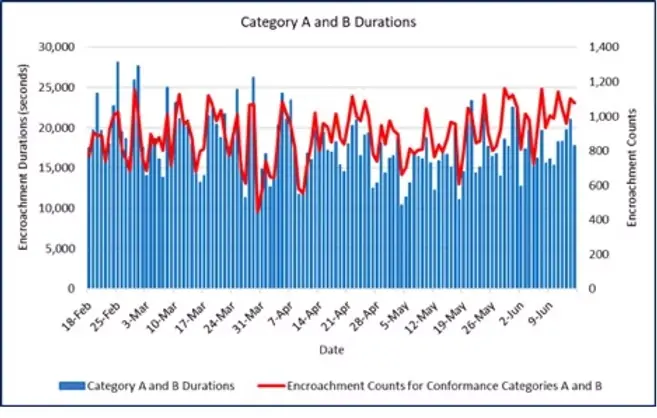
The Aviation Safety Monitor summarizes output from Risk Tracker, the Robust Analytics in-time terminal airspace hazard and safety metrics monitoring system.
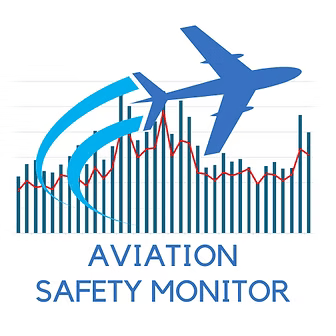
About the Aviation Safety Monitor
The Aviation Safety Monitor is a service provided by Robust Analytics to deliver timely information on terminal area safety in the National Airspace System (NAS). The safety monitoring and prediction technologies were developed by Robust Analytics over the past several years. Partial funding was provided by the NASA Small Business Innovation Research Program and the NASA System Wide Safety Project.
The Aviation Safety Monitor provides quantitative estimates of safety margins at 26 airports in 17 metropolitan regions in the United States. This information complements data on several safety-related events that are published elsewhere, with the FAA’s Runway Incursion Statistics website a good example. However, the available safety information can be misleading if it only reports the frequency of violations with no insight into how safety buffers may vary minute-to-minute and day-to-day. The Aviation Safety Monitor aims to provide this insight every week.
